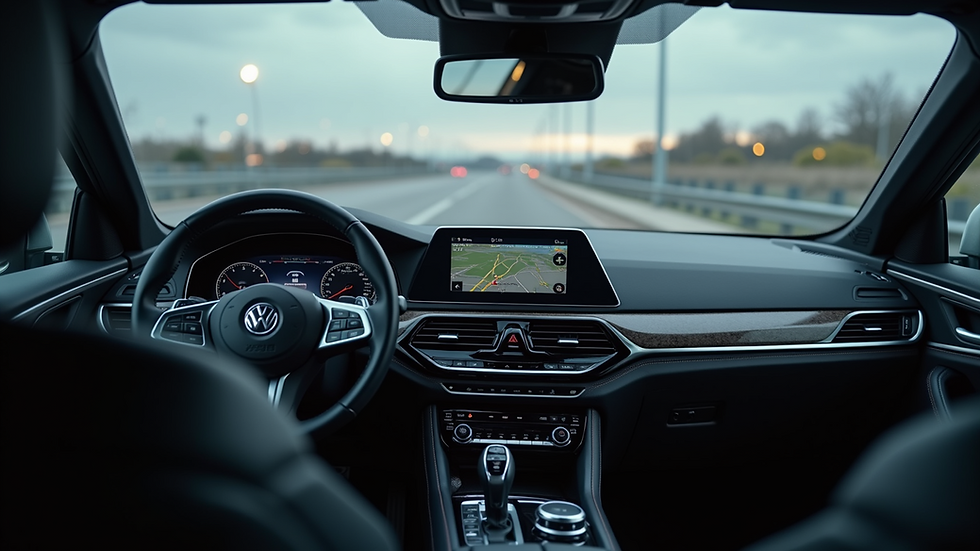The Evolution of Modern Driving Experiences
- Oct 10
- 4 min read
Driving has transformed significantly over the decades, evolving from a basic means of transportation to a more immersive experience contributed by technology, design, and user preferences. Let’s delve into the evolution of modern driving experiences, exploring how advancements in automotive engineering, technological integration, and social changes have shaped the way we drive.
Driving Experiences Through the Ages
In the early days of automobiles, driving was straightforward and focused primarily on getting from point A to point B. Cars were often seen as a luxury, and driving was an experience rooted in the mechanical aspects of the vehicle. As the automotive industry evolved, so did consumer expectations.
In the 1980s and 1990s, car manufacturers began incorporating more safety features like airbags and anti-lock brakes. This shift prioritized the driver’s safety while simultaneously enhancing the driving experience. The introduction of systems like GPS navigation in the early 2000s marked the beginning of integrating digital technologies into our vehicles, making the driving experience not only safer but also more convenient and user-friendly.

The Role of Technology in Modern Driving
The most significant change in driving experiences can be attributed to technology. The advent of smart technology in cars has transformed how we interact with vehicles. Key features like infotainment systems, voice control, and smartphone connectivity have become standard in many modern cars.
Consider the rise of self-driving vehicles. Companies like Tesla are at the forefront of this revolution, offering features that allow cars to navigate roads with minimal human intervention. Statistics reveal that driving automation could potentially reduce traffic accidents by 94% if fully implemented. As more consumers become familiar with these technologies, their expectations for driving experiences have shifted dramatically.
Connected Cars: Changing the Game
The concept of connected cars is changing the way we think of driving experiences. By integrating the Internet of Things (IoT) into vehicles, cars can communicate with other devices, offering real-time information about traffic, weather, and vehicle health. This connectivity is not just a trend; it’s paving the way for smarter cities and more efficient travel.
For instance, adaptive cruise control and lane-keeping assistance are features designed to enhance not only the safety aspects but also the driving pleasure. Imagine a commute where the vehicle automatically adjusts to stop-and-go traffic, providing a smoother, less stressful experience. This feature alone is a testament to how technology is enhancing our driving experiences.

Eco-Friendly Driving Experiences
With growing concerns about climate change, the push for eco-friendly vehicles has significantly altered modern driving experiences. Electric vehicles (EVs) and hybrid models are no longer niche markets but have become mainstream options. With advancements in battery technology, EVs can now travel longer distances, making them more practical for daily use.
Statistics show that global sales of electric cars surpassed 6.6 million units in 2021, up from just 2 million in 2018. This surge indicates a shift in consumer preferences as more individuals seek sustainable alternatives. Associated innovations like regenerative braking—where energy is recaptured during braking—also enhance the driving experience by making these vehicles more efficient.
Owning an electric vehicle can redefine the driving experience, allowing users to take part in eco-friendly initiatives while enjoying the benefits of advanced automotive technology. Moreover, as charging infrastructure expands, making these vehicles more accessible and convenient to operate, the modern driving experience will only continue to evolve.
A Shift in Social Perspectives
The evolution of modern driving experiences goes beyond technology and vehicles—it encompasses changes in societal attitudes towards transportation. In urban areas, there’s a growing preference for ridesharing services and public transportation as alternatives to car ownership.
According to recent studies, rideshare services have increased by over 27% since 2019. This trend reflects a shift towards valuing convenience and social responsibility over personal car ownership, especially among younger generations. As we move away from individual ownership and embrace shared experiences, driving is no longer a solitary activity.
Innovations in ridesharing and mobility as a service (MaaS) will shape the future of how we travel. By utilizing platforms that connect users to different modes of transport, the complete journey can be more efficient and enjoyable. This societal shift is likely to redefine our understanding of driving experiences as collective rather than individual.

The Future of Driving Experiences
The future of driving experiences is bright, filled with promise and excitement. With continuing advancements in autonomous vehicle technology, the possibilities are near endless. As more cities adapt to accommodate smart vehicles, we could see a significant transformation in urban planning and design.
Fleet operations driven by AI and data analytics will likely optimize routes, decrease emissions, and further enhance the experience for drivers and passengers alike. While navigating through self-driving cars may still feel like science fiction, extensive testing and consumer acceptance are bringing this reality closer than ever.
As consumers, it will be crucial to remain informed about these developments. Engaging with platforms such as venture bound can further enhance our understanding of not just vehicles, but the entire environment in which we drive.
In conclusion, the evolution of driving experiences is a reflection of technological advancements, societal changes, and increased environmental awareness. Understanding these trends will not only help us adapt but also allow us to enjoy every mile driven. The landscape of driving is constantly changing, and as we embrace these developments, we can look forward to more enjoyable and meaningful driving experiences in the future.





Comments